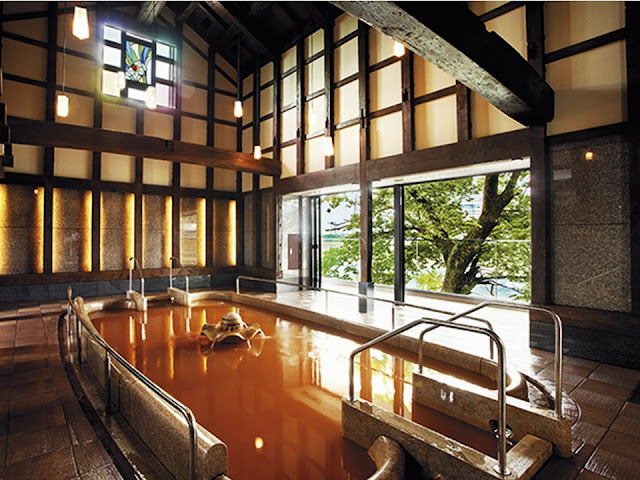The hotel was founded in 1860 beside the scenic Nagara River in central Japan; visitors come to enjoy ukai (cormorant fishing) or playing at the river. Traveling, soaking in a hot spring and eating local cuisine are definitely fun for everyone.
1860年創業のお宿です。風光明媚で、長良川の川遊びや鵜飼いを楽しむ人たちが泊まります。旅して、温泉に浸かり、食事を楽しむ、鉄板の楽しみですね。
The hotel suites the street which was a river port.
かつて川湊だった通りに馴染んだ建物、そして玄関です。
Behind the entrance hall, the hotel history is introduced. The hotel was named in 1860, but they started operation sixteen to thirty years before.
玄関ホール先では、宿の歴史が紹介されています。十八楼という名にしたのが1860年で、その16~30年前には宿を営んでいたそうです。天保の頃です。
The photo above is a picture map of pontoon bridge (1874). Nagara River is rapids, so a pontoon bridge was used because it was easy to reconstruct. The hotel (Juhachiro) is depicted on the map.
明治7年の「船橋の図」です。長良川は流れが速かったので、再建が容易な船橋にしたそうです。この年に作られました。十八楼もしっかりと記載されています。
The photo in the early 20th century shows an iron bridge and the wooden hotel which was three-story building.
大正期の写真には、木造三階建ての宿がしっかり写っていて、鉄橋の長良橋ができています。
Visitors who came in around 1950 enjoyed boat riding; the roof top would be a first-class section. They are all men.
舟遊びを楽しむお客様(昭和20~30年)。屋根の上は特等席ですね。男ばかりだなあ。
The wood print above which depicts ukai in Nagara River was sold as a souvenir in the late 19th century. Basho’s haiku (short poem) is printed on it; he (1644~1694) was a great haiku master. It means “Every thing I can see here is cool.”
「長良川鵜飼の図」(版画)は、明治時代にお土産品として販売していたそうです。「この辺り 目に見ゆるものは 皆涼し」と芭蕉の句も刷られています。
We can see Nagara River from the lounge of the hotel.
ラウンジからは長良川が見えます。
Utensils which were used in the first half of the 20th century are displayed around the lounge.
ラウンジの周りには、大正から戦前まで使われていた道具が展示されています。
The hand sanitizer pump wears kimono.
廊下に置かれている消毒液は、オシャレにラッピングされていました。
There are also panels and exhibits in a hallway.
廊下にもパネルと展示品が置かれています。
There is a bathroom at the end of the hallway.
廊下を進むとお風呂があります。
It is prohibited to take photos inside the bathroom, so I upload the photo of the hotel website (https://www.18rou.com/spa/). It is a good hot spring which contains rich iron, therefore the color changes to reddish brow after exposing to air. We can see the river from the bathtub; It’s a comfortable bathroom.
お風呂は撮影禁止なので、宿のホームページの写真(https://www.18rou.com/spa/)を使わせていただきました。鉄分豊富な長良川温泉は、透明なのですが、空気に触れるとご覧の通り赤褐色になります。川を望む、良いお風呂でした。
After bathing, we had dinner. It’s a beautiful and delicious course meal.
お風呂のあとは夕食。お料理は美しく、美味しかったです。
Assorted vegetables beside the grilled fish are called “Assorted Luck”. The name of every ingredient contains “un(ん)” which means “luck” in Japanese.
鰈の西京焼き(御家喜物)の横には「運盛り」が添えられていました。「ん」がつく素材の盛り合わせです。
In most course meal of Japanese hotel (Ryokan), we eat rice before dessert. A rice porridge with ayu fish was served; ayu was torn into pieces and put in the porridge. It’s tasty and was easy to eat. Although I could not show you all meals, other dishes such as a hot pot of Hida-gyu (wagyu beef) were also good.
食事は鮎雑炊でした。鮎がどーんと入っているのではなく、味を出しているという感じでこれも美味しかった。紹介しきれませんが、名物の「飛騨牛の牛鍋」など品数、量ともに十分でした。
It’s a calm room; we can see Nagara River from the room.
落ち着くお部屋で、左側の障子を開けるとすぐしたが長良川です。
The hotel (Juhachiro) is located in the town which was a river port; Mino paper and lumbers were shipped from the port. The hotel holds a free guided tour in evening; it takes 30 min.
十八楼は、かつての川湊にあります。美濃和紙や木材などを全国に輸出していました。夕方に無料のガイドツアー(30分)が催行されていました。
If you want to watch ukai from a boat, visit this building (Gifu City Cormorant Fishing Observation Boat Office) on the same street from May to October.
Official website: https://www.ukai-gifucity.jp/Ukai/e/
鵜飼い観覧船乗り場の横には灯台も作られています。ここは、「湊町」と呼ばれています。
It’s a view of the hotel from Gifu Castle.
岐阜城から見た十八楼です。
Visited
in January, 2022
Official
website: https://www.18rou.com/en/
https://www.18rou.com/ (in Japanese), accessed in May, 2022
Previous post (Cormorant fishing museum
in Gifu City) : Nagaragawa Ukai Museum、長良川うかいミュージアム
Next post (Longstanding castle and its castle town): Inuyama Castle and museums、犬山城と城下の資料館




















Comments
Post a Comment